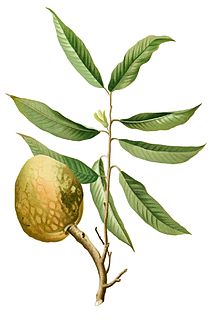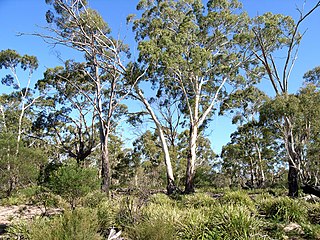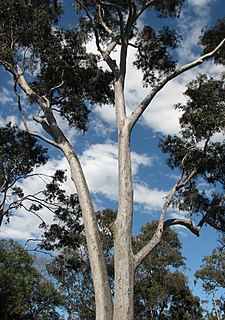
The papaya, papaw or pawpaw is the plant Carica papaya, one of the 22 accepted species in the genus Carica of the family Caricaceae. Its origin is in the tropics of the Americas, perhaps from Central America and southern Mexico.

Morus, a genus of flowering plants in the family Moraceae, consists of diverse species of deciduous trees commonly known as mulberries, growing wild and under cultivation in many temperate world regions. Generally, the plant has three main species by color of its fruits: white, red, and black mulberry, with numerous cultivars, but more than 200 species are identified in taxonomy. It is native to Southern Asia, but is widely distributed across Europe, South Africa, South America, and North America. It is regarded as an invasive species in Brazil.

The jackfruit, also known as jack tree, is a species of tree in the fig, mulberry, and breadfruit family (Moraceae). Its origin is in the region between the Western Ghats of southern India and the rainforests of Malaysia.

Campanula is one of several genera of flowering plants in the family Campanulaceae with the common name bellflower. It takes both its common and its scientific name from its bell-shaped flowers—campanula is Latin for "little bell".

Olea is a genus of about 40 species in the family Oleaceae, native to warm temperate and tropical regions of the Middle East, southern Europe, Africa, southern Asia, and Australasia. They are evergreen trees and shrubs, with small, opposite, entire leaves. The fruit is a drupe. Leaves of Olea contain trichosclereids.

Leucanthemum is a genus of flowering plants in the aster family, Asteraceae. It is mainly distributed in southern and central Europe. Some species are known on other continents as introduced species, and some are cultivated as ornamental plants. The name Leucanthemum derives from the Greek words λευκός – leukos ("white") and ἄνθεμον – anthemon ("flower").

Canarium is a genus of about 100 species of tropical and subtropical trees, in the family Burseraceae. They grow naturally across tropical Africa, south and southeast Asia, Indochina, Malesia, Australia and western Pacific Islands; including from southern Nigeria east to Madagascar, Mauritius, Sri Lanka and India; from Burma, Malaysia and Thailand through the Malay Peninsula and Vietnam to south China, Taiwan and the Philippines; through Borneo, Indonesia, Timor and New Guinea, through to the Solomon Islands, New Caledonia, Fiji, Samoa, Tonga and Palau.

Annona reticulata is a small deciduous or semi-evergreen tree in the plant family Annonaceae and part of the Annonas group. It is best known for its fruit, called custard apple, a common name shared with fruits of several other species in the same genus: A. cherimola and A. squamosa. Its common names include wild-sweetsop, bull's heart, bullock's-heart, or ox-heart. The fruit is sweet and useful in preparation of desserts, but is generally less popular for eating than that of A. cherimola.

Lawsonia inermis, also known as hina, the henna tree, the mignonette tree, and the Egyptian privet, is a flowering plant and the sole species of the genus Lawsonia. It is the source of the dye henna used to dye skin, hair and fingernails, as well as fabrics including silk, wool and leather.

Lansium parasiticum, commonly known as langsat or lanzones in English; or duku or dokong in Malay, is a species of tree in the Mahogany family with commercially cultivated edible fruits. The species is native to Southeast Asia.

Pterospermum is a flowering plant genus. Traditionally included in the family Sterculiaceae, it is included in the expanded Malvaceae in the APG and most subsequent systematics. Pterospermum is based on two Greek words, "Pteron" and "Sperma," meaning "winged seed."

Eucalyptus viminalis, commonly known as the manna gum, white gum or ribbon gum, is species of small to very tall tree that is endemic to south-eastern Australia. It has smooth bark, sometimes with rough bark near the base, lance-shaped to curved adult leaves, flower buds in groups of three or seven, white flowers and cup-shaped or hemispherical fruit.

Leucaena leucocephala is a small fast-growing mimosoid tree native to southern Mexico and northern Central America and is now naturalized throughout the tropics.

Banksia goodii, commonly known as Good's banksia, is a species of prostrate shrub that is endemic to a small area in the south-west of Western Australia. It has densely hairy stems, wavy, oblong to egg-shaped leaves with irregularly serrated margins, rusty-brown flowers and hairy fruit. It grows in low forest and woodland near Albany and is listed as "vulnerable".

Corymbia maculata, commonly known as spotted gum, is species of medium-sized to tall tree that is endemic to eastern Australia. It has smooth, mottled bark, lance-shaped to curved adult leaves, flower buds usually in groups of three, white flowers and urn-shaped or barrel-shaped fruit.

The Nanking cherry is a species of Prunus native to northern and western China, Korea, Mongolia, and possibly northern India. Other common names for P. tomentosa include Korean cherry, Manchu cherry, downy cherry, Shanghai cherry, Ando cherry, mountain cherry, Chinese bush cherry, or Chinese dwarf cherry.

Pterospermum acerifolium, the bayur tree or karnikara tree, is a flowering plant indigenous to Southeast Asia, from India to Burma. It is most likely to grow naturally along forested stream banks. The best growing conditions are a seasonally moist then dry climate with access to full sunlight. Pterospermum acerifolium is an angiosperm that is traditionally included in the family Sterculiaceae; however, it is grouped in the expanded family Malvaceae as well. The classification Pterospermum is based on two Greek words, Pteron and Sperma, meaning “winged seed” and the species name acerifolium indicates leaves shaped like a maple's. There is an array of common names for Pterospermum acerifolium, depending on the region where it is grown. It is commonly referred to as Kanak Champa, Muchakunda or Karnikar Tree within its native range. In the Philippines, it is known as Bayog. Other common names include Bayur Tree, Maple-Leafed Bayur Tree, and Dinner Plate Tree. It is a relatively a large tree, growing up to thirty meters tall. Mostly planted as an ornamental or shade tree, the leaves, flowers, and wood of a Bayur Tree can serve a variety of functions.

Solanum virginianum, also called Surattense nightshade, yellow-fruit nightshade, yellow-berried nightshade, Thai green eggplant, Thai striped eggplant, is also known as Indian night shade or yellow berried night shade plant, the common name is Kantakari, Solanumsurattense Brum. f. and Solanum xanthocarpum Schrad. and Wendl. are synonyms of Solanum virginianum L.. It is also a medicinal plant used mostly in India. Some part of the plant is poisonous ex. the fruit which is poisonous.
Ochna lanceolata is a species of plant in the family Ochnaceae. It is native to India and Sri Lanka.
Chellapilla Venkata Rao (1910–1971) was an Indian botanist.


















